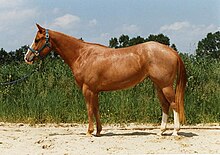Cerbat mustang: Difference between revisions
added Category:Horses using HotCat |
Filled in 3 bare reference(s) with reFill () |
||
| Line 23: | Line 23: | ||
==Characteristics== |
==Characteristics== |
||
[[File:Roan.jpg|left|thumb|A roan horse]] |
[[File:Roan.jpg|left|thumb|A roan horse]] |
||
The Cerbat Mustang is similar to the Andalusian horse in conformation. It is almost always bay, chestnut or roan in color. Uniquely, roan Cerbat foals are born roan, unlike roan foals of other breeds that are born a dark color and "roan out" as they get older, fading in color.<ref>https://books.google.com/books?id=PS6zop4lVSUC&pg=PA96&dq=cerbat+mustang&hl=en&sa=X&ved=0ahUKEwijzYimucXKAhVL4yYKHd8LBx0Q6AEIPDAD#v=onepage&q=cerbat%20mustang&f=false</ref> Cerbats have a rare kind of [[DNA]] called transferrin that helps fight some diseases. |
The Cerbat Mustang is similar to the Andalusian horse in conformation. It is almost always bay, chestnut or roan in color. Uniquely, roan Cerbat foals are born roan, unlike roan foals of other breeds that are born a dark color and "roan out" as they get older, fading in color.<ref name="Storey">{{cite web|url=https://books.google.com/books?id=PS6zop4lVSUC&pg=PA96&dq=cerbat+mustang&hl=en&sa=X&ved=0ahUKEwijzYimucXKAhVL4yYKHd8LBx0Q6AEIPDAD#v=onepage&q=cerbat%20mustang&f=false|title=Storey's Illustrated Guide to 96 Horse Breeds of North America|publisher=|accessdate=31 January 2016}}</ref> Cerbats have a rare kind of [[DNA]] called transferrin that helps fight some diseases. |
||
==Origin== |
==Origin== |
||
The Cerbat Mustang was brought to the US by [[Spanish conquistadors]]. They fall into the [[Colonial Spanish horse]] type.<ref>https://books.google.com/books?id=bE-iL3YtmlkC&pg=PA320&dq=cerbat+mustang&hl=en&sa=X&ved=0ahUKEwijzYimucXKAhVL4yYKHd8LBx0Q6AEITzAG#v=onepage&q=cerbat%20mustang&f=false</ref><ref |
The Cerbat Mustang was brought to the US by [[Spanish conquistadors]]. They fall into the [[Colonial Spanish horse]] type.<ref>{{cite web|url=https://books.google.com/books?id=bE-iL3YtmlkC&pg=PA320&dq=cerbat+mustang&hl=en&sa=X&ved=0ahUKEwijzYimucXKAhVL4yYKHd8LBx0Q6AEITzAG#v=onepage&q=cerbat%20mustang&f=false|title=America's Last Wild Horses|publisher=|accessdate=31 January 2016}}</ref><ref name="Storey"/><ref>{{cite web|url=https://books.google.com/books?id=CdJg3qXssWYC&pg=PA115&dq=cerbat+mustang&hl=en&sa=X&ved=0ahUKEwijzYimucXKAhVL4yYKHd8LBx0Q6AEIKjAA#v=onepage&q=cerbat%20mustang&f=false|title=International Encyclopedia of Horse Breeds|publisher=|accessdate=31 January 2016}}</ref> They have been identified to be a type of Spanish Mustang and are found mainly in [[Arizona]]. There is a theory that a Spanish explorer named [[Coronado, Francisco Vasquez de|Coronado]] had about 1,500 horses with him while he was traveling in the southwest of Arizona in the 1500s. The Cerbats that he had might've gotten loose and wandered off and in conclusion, becoming a Arizonian horse. Their name comes from the place they got lost, the [[Cerbat Mountains]]. Other theories say they might've gotten lost from early explorers in the 1700s, or escaped from ranch owners in the 1800s. |
||
==Uses== |
==Uses== |
||
| Line 33: | Line 33: | ||
== References == |
== References == |
||
<!--- See http://en.wikipedia.org/wiki/Wikipedia:Footnotes on how to create references using |
<!--- See http://en.wikipedia.org/wiki/Wikipedia:Footnotes on how to create references using tags, these references will then appear here automatically --> |
||
{{Reflist}} |
{{Reflist}} |
||
Revision as of 23:27, 31 January 2016
This article, Cerbat mustang, has recently been created via the Articles for creation process. Please check to see if the reviewer has accidentally left this template after accepting the draft and take appropriate action as necessary.
Reviewer tools: Inform author |
 Comment: Improve references. In place of references to Google Books, refer to the books themselves. Statements such as "Other theories say they might've gotten lost from early explorers in the 1700s, or escaped from ranch owners in the 1800s" should be attributed. Robert McClenon (talk) 22:51, 30 January 2016 (UTC)
Comment: Improve references. In place of references to Google Books, refer to the books themselves. Statements such as "Other theories say they might've gotten lost from early explorers in the 1700s, or escaped from ranch owners in the 1800s" should be attributed. Robert McClenon (talk) 22:51, 30 January 2016 (UTC)
This article may require copy editing for grammar, style, cohesion, tone, or spelling. |
| Country of origin | USA |
|---|---|
| Traits | |
| Distinguishing features | Head is similar to the Andalusian horse. They are only chestnut, bay, and roan. At average, they are also about 14.2 to 15 hands tall. |
The Cerbat Mustang is a breed of Mustang originating in the USA. Their main coat colors are chestnut, bay, and roan. Their heads are similar to those of the Andalusian horse. They are usually intelligent and are willing to learn. It is also unclear of the actual history of Cerbat Mustangs. They are nearly extinct due to the drought that force humans to kill them for food. It has been identified that Cerbat Mustangs have Spanish blood and that they are Spanish Mustangs.
Characteristics

The Cerbat Mustang is similar to the Andalusian horse in conformation. It is almost always bay, chestnut or roan in color. Uniquely, roan Cerbat foals are born roan, unlike roan foals of other breeds that are born a dark color and "roan out" as they get older, fading in color.[1] Cerbats have a rare kind of DNA called transferrin that helps fight some diseases.
Origin
The Cerbat Mustang was brought to the US by Spanish conquistadors. They fall into the Colonial Spanish horse type.[2][1][3] They have been identified to be a type of Spanish Mustang and are found mainly in Arizona. There is a theory that a Spanish explorer named Coronado had about 1,500 horses with him while he was traveling in the southwest of Arizona in the 1500s. The Cerbats that he had might've gotten loose and wandered off and in conclusion, becoming a Arizonian horse. Their name comes from the place they got lost, the Cerbat Mountains. Other theories say they might've gotten lost from early explorers in the 1700s, or escaped from ranch owners in the 1800s.
Uses

Cerbat Mustangs are used in Endurance riding, and Eventing.
References
- ^ a b "Storey's Illustrated Guide to 96 Horse Breeds of North America". Retrieved 31 January 2016.
- ^ "America's Last Wild Horses". Retrieved 31 January 2016.
- ^ "International Encyclopedia of Horse Breeds". Retrieved 31 January 2016.
External links
http://www.theequinest.com/breeds/cerbat-mustang/
http://lenjohnsonproductions.blogspot.com/2014/10/cerbat-spanish-mustang-history.html

